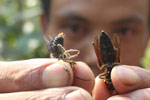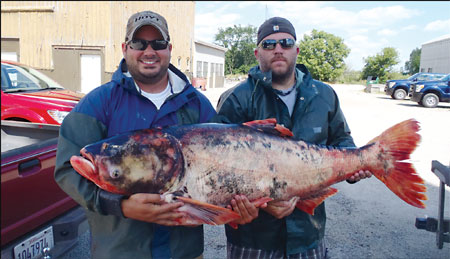The fish that didn't get away
Updated: 2013-10-18 13:03
By Caroline Berg (China Daily USA)
|
||||||||
|
An 82-pound bighead carp was caught in an Illinois pond in August. The Illinois Department of Natural Resources is working on making a life-size replica of the fish for outreach and education purposes. Courtesy of Illinois Department of Natural Resources |
In the 1960s, scientists in China artificially spawned Asian carp. Now the fish poses a threat to the US fish ecosystem as well as commercial fishing and recreational water activities, reports Caroline Berg in New York.
It began in China in the 1960s. That's when scientists discovered the key to creating artificial conditions to support spawning of the Asian carp fish. After that, carp-based aquaculture took off worldwide.
Seven different species of the filter-feeding fish were shipped to the US to help control weeds and parasites in aquaculture operations in the South. In 1972, the silver carp variety was introduced into the US from China.
Fast forward 41 years and more than a thousand miles north on the Mississippi River to southern Minnesota where on a concrete abutment a silver carp was found dead after trying to clear a dam on the river.
"Invasive carp: Leaping silver carp found dead in Winona - farthest upstream fish yet," read one newspaper headline after the discovery in late August.
Silver carp have been creeping up the Mississippi River basin for decades, hoarding the food eaten by native fish and spreading concern into Canada because carp pose a serious threat to the ecosystem of other fish, commercial fishing and recreational water activities.
And the immediate concern is that the fish threaten the Great Lakes.
The silver carp is enemy No 1 among four species of invasive Asian carp moving toward the five lakes, including the sometimes human-sized bighead carp, as well as the grass and black carps.
Besides Minnesota, the states and provinces that border the Great Lakes include Illinois, Indiana, Michigan, New York, Ohio, Pennsylvania, Wisconsin, Ontario and Quebec. The Chicago Sanitary and Ship Canal (CSSC) is a focal point in this region because the man-made waterway provides a direct connection between the Mississippi River and Lake Michigan.
The leading edge of the Asian carp population is about 25 miles downstream near Lockport, Illinois, according to the Illinois Department of Natural Resources (DNR).
Kevin Irons of the DNR said representatives from Quebec all the way to Wisconsin and Minnesota are meeting to figure out goals and policies to protect the five Great Lakes from an Asian carp invasion.
"Communication has been ramped up," Irons told China Daily. "We talk often with our Great Lakes brothers and sisters, the other provinces and states. We're sharing and learning very quickly ways in which we can tackle this issue."
"Having things like the electric barrier in place, I think we can do really well in keeping the fish out of Lake Michigan, and also reduce the impact in places where they have been thriving," Irons said.
The size of the Asian carp population in the US remains uncertain, but the Illinois DNR and local fisheries estimate 4 million to 10 million pounds of the fish reside in the 150 miles of the Illinois River on either side of Peoria, which is considered the epicenter of carp activity.
Irons said he has seen places on the Illinois River where Asian carp make up perhaps 60 percent of the biomass. He said the carp have yet to cause a native species to become extinct, but officials have noted that populations of indigenous fish like Bigmouth Buffalo and Gizzard Shad have thinned.
Three years ago, a 19-pound Asian carp was pulled from Lake Calumet, about six miles from Lake Michigan, and evidence north of the barriers revealed Asian carp environmental DNA, which fish shed in their excrement, scales and body slime.
Bighead and silver carp have voracious appetites and feast on plant and animal plankton. They are capable of eating 5 percent to 20 percent of their body weight each day, and some may reach 110 pounds, although the average size is about 30 pounds to 40 pounds.
In addition to outdoing native fish for food, Asian carp are known to reproduce like rabbits. A female bighead can carry up to 1 million eggs in a lifetime, according to Jennifer Nalbone, formerly of Great Lakes United, the only bi-national coalition organized around Great Lakes environmental protection, which permanently shut down this summer. A study by Fisheries and Oceans Canada reported that only 10 females and 10 males would be needed to establish a sustainable population.
Silver carp are infamously skittish. When boat motors rumble, the fish are easily startled and may leap as high as 10 feet out of the water, posing a threat to recreational and commercial water activities because they can harm people or damage boats.
The Great Lakes hold 21 percent of the world's fresh water, and annual revenue from commercial and sport fisheries, tourism and recreational industries totals more than an estimated $9 billion.
More than 250 non-native species are already established in one or both of the Great Lakes and Mississippi basins, and invasive species cost the Great Lakes region alone an estimated $200 million annually, according to a report by the Great Lakes Commission.
In addition to erecting electric barriers to halt the mobility of aquatic invasive species, businesses have been setting up an Asian carp trade with China, and state and federal governments have used a poison in the waterways to net carp by the tens of thousands as part of an $80-million effort to prevent the outsiders from infiltrating the Great Lakes basin.
Between 5 million and 10 million pounds of fish are hauled out of the Illinois River every year, according to Irons, who said he would like to see 20 million to 50 million pounds extracted annually to better control the population.
Most Viewed
Editor's Picks

|

|

|

|

|

|
Today's Top News
China has to brace for next dollar drama
Life of Pi artwork on display
No criminal charges in Asiana crash death: DA
US deal key to nabbing fugitives
Seattle high-tech summit talks 'green'
JPMorgan reaches $13b deal
China is reaching its tipping point
Beijing works to spur global development
US Weekly

|

|
















